|
|
|
Sort Order |
|
|
|
Items / Page
|
|
|
|
|
|
|
| Srl | Item |
| 1 |
ID:
125136
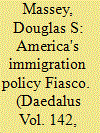

|
|
|
|
|
| Publication |
2013.
|
| Summary/Abstract |
In this essay I discuss how and why U.S. policies intended to stop Latin American immigration to the United States not only failed, but proved counterproductive by ultimately accelerating the rate of both documented and undocumented migration from Mexico and Central America to the United States. As a result, the Latino population grew much faster than demographers had originally projected and the undocumented population grew to an unprecedented size. Mass illegality is now the greatest barrier to the successful integration of Latinos, and a pathway to legalization represents a critical policy challenge. If U.S. policy-makers wish to avoid the failures of the past, they must shift from a goal of immigration suppression to one of immigration management within an increasingly integrated North American market.
|
|
|
|
|
|
|
|
|
|
|
|
|
|
|
|
| 2 |
ID:
105566
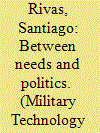

|
|
|
| 3 |
ID:
015717


|
|
|
|
|
| Publication |
Summer 1992.
|
| Description |
401-415
|
|
|
|
|
|
|
|
|
|
|
|
|
|
|
|
| 4 |
ID:
108897
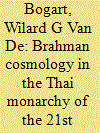

|
|
|
| 5 |
ID:
121216


|
|
|
|
|
| Publication |
2012.
|
| Summary/Abstract |
Since 1940 the Americas have been fairly peaceful compared to other regions
of the world. Although Central America was racked by extremely violent civil
wars during the 1980s, over the past few decades the region as a whole has
not experienced many military con?icts between states. Barely a handful of
the various territorial disputes, past or present, have led to open warfare. The
last signi?cant episode, the 1995 war between Peru and Ecuador, lasted no
more than a week. Yet this relative tranquillity must not obscure the fact that
over the years, the regional security agenda has undergone major changes.
|
|
|
|
|
|
|
|
|
|
|
|
|
|
|
|
| 6 |
ID:
108349
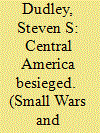

|
|
|
|
|
| Publication |
2011.
|
| Summary/Abstract |
The following is a threat assessment of the seven countries that make up Central America. That region is struggling to control burgeoning street gangs and organized criminal groups which have overrun its poor and ill-prepared security forces. The results are clear: rising crime and homicide rates throughout the region; corruption and instability within the governments. The two gangs that challenge authority are transnational in nature but pose less a threat to national security than they do to everyday life. Their drug peddling and extortion have shattered entire communities and forced the governments to reallocate important resources. The governments' strategy of jailing suspected gang members en masse has arguably made them stronger rather than weaker. Meanwhile, the organized criminal groups have deeply penetrated governments at nearly every level. They control swaths of territory, co-opting these areas, as well as the local governments, for their own purposes. Opposition to them is often futile. Mexican-based organizations are increasingly using violent tactics to displace their rivals. The governments of the region seem unprepared to meet the challenge.
|
|
|
|
|
|
|
|
|
|
|
|
|
|
|
|
| 7 |
ID:
142071
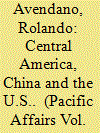

|
|
|
|
|
| Summary/Abstract |
Central America remains among the poorest sub-regions of Latin America, and many Central American countries are among the hemisphere’s most dependent upon primary-product exports. Unlike other commodity exporters in Latin America, however, Central American countries have not benefited from booming Chinese demand for primary products. We use a series of measures to assess Central American countries’ trade structure, and find that they face increasing competition from Chinese products in third country markets (like issue_image_88_4_Central Am China US_bananas_costa rica_AvendanaMexico) but also little complementarity with Chinese demand (unlike Argentina or Chile). Central American countries continue to be very dependent upon the US market for exports—and, to a lesser extent, for foreign direct investment and foreign aid inflows—though dependence upon the US has slipped even as most of the countries in the sub-region have entered into a preferential trade agreement with the US. The pattern of exports has shifted from agricultural to assembly plant manufactures in several countries, and Costa Rica now exports sophisticated manufactured products to the US and China alike. We explore the role that diplomatic relations may have played in Central America’s tepid China trade: all Central American countries save Costa Rica (since 2007) recognize Taiwan and not the People’s Republic of China. We end with some considerations of development strategies in the region.
|
|
|
|
|
|
|
|
|
|
|
|
|
|
|
|
| 8 |
ID:
076567
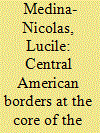

|
|
|
| 9 |
ID:
027819
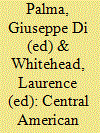

|
|
|
|
|
| Publication |
Beckenham, Friedrich Naumann Foundation, 1986.
|
| Description |
252p.
|
| Standard Number |
0709936605
|
|
|
|
|
|
|
|
|
|
|
|
Copies: C:1/I:0,R:0,Q:0
Circulation
| Accession# | Call# | Current Location | Status | Policy | Location |
| 026975 | 320.973/PAL 026975 | Main | On Shelf | General | |
|
|
|
|
| 10 |
ID:
099865
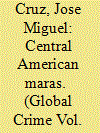

|
|
|
|
|
| Publication |
2010.
|
| Summary/Abstract |
Most of the empirical research on Central American street gangs, called maras, has been published only in Spanish. Reviewing that literature, the American scholarship on gangs, and my own research on Central American gangs from the mid-1990s, this article depicts the processes through which the maras (Mara Salvatrucha and the Eighteenth Street Gang) evolved from youth street gangs in the late 1980s to protection rackets with features of transnational organisations. Intense migratory flows between El Salvador, Guatemala, Honduras, and the United States, and the hard-line suppression policies against youth gangs in institutionally weak Central American countries created the conditions that prompted networking and organisation among Central American street gangs. This article highlights the changes in the dynamics of violence and the transformations in the gangs' social spaces to illustrate the evolution of the maras.
|
|
|
|
|
|
|
|
|
|
|
|
|
|
|
|
| 11 |
ID:
127616
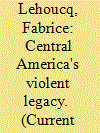

|
|
|
|
|
| Publication |
2014.
|
| Summary/Abstract |
Armed conflict liquidated Central America's dictatorships by the end of the twentieth century. Only Costa Rica was democratic when a wave of civil wars broke out in the 1970s; by the mid-1990s, every country on the isthmus had replaced dictators or military juntas with elected presidents and legislators. Every nation in the region now allows adults at least 18 years old (or 16, in Nicaragua) to cast ballots in regularly scheduled elections
|
|
|
|
|
|
|
|
|
|
|
|
|
|
|
|
| 12 |
ID:
138412
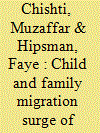

|
|
|
|
|
| Summary/Abstract |
In the summer months of 2014, a surge in the number of unaccompanied alien children (UAC) and family units from Central America arriving at the U.S.-Mexico border precipitated a crisis for the U.S. government and a firestorm in political and media circles. In recent years, no issue in regional migration (involving the United States, Mexico, and Central America) has attracted this level of red-hot attention and controversy. This article will first examine the numbers—and the trends—of the migration of unaccompanied children prior to and in the wake of this summer’s crisis. It will explore the complex set of push and pull factors responsible for the surge, including security concerns in Central America, structural economic dynamics in the region, the desire for family reunification, U.S. immigration policies that mandate special treatment of child migrants, and the role of smuggling networks. It will survey the policy responses of the governments of the United States, Mexico, El Salvador, Guatemala, and Honduras to the surge—and their impacts. Further, it will examine the ramifications of the child migration influx at the federal, state, and local levels in the United States, as well as the effects of the crisis on the broader political immigration debate in the United States. Lastly, the article will offer recommendations on how to better respond to child migration—both in the short term and on an ongoing, long-term basis.
|
|
|
|
|
|
|
|
|
|
|
|
|
|
|
|
| 13 |
ID:
052843


|
|
|
| 14 |
ID:
124944
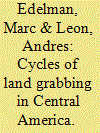

|
|
|
|
|
| Publication |
2013.
|
| Summary/Abstract |
The lack of historical perspective in many studies of land grabbing leads researchers to ignore or underestimate the extent to which pre-existing social relations shape rural spaces in which contemporary land deals occur. Bringing history back in to land grabbing research is essential for understanding antecedents, establishing baselines to measure impacts and restoring the agency of contending agrarian social classes. In Central America each of several cycles of land grabbing-liberal reforms, banana concessions and agrarian counter-reform-has profoundly shaped the period that succeeded it. In the Bajo Aguán region of Honduras-a centre of agrarian reform and then counter-reform-violent conflicts over land have been materially shaped by both peasant, landowner and state repertoires of contention and repression, as well as by peasants' memories of dispossession.
|
|
|
|
|
|
|
|
|
|
|
|
|
|
|
|
| 15 |
ID:
155141
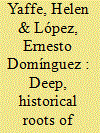

|
|
|
|
|
| Summary/Abstract |
Colonialism, imperialism and anti-imperialism have been decisive in shaping Cuban political identity for 150 years. US determination to control Cuba, consistent with the Monroe Doctrine, had a strong economic rationale even before Spain was defeated in the War of Independence in 1898. Debate raged between Cubans who aspired to true independence and an annexationalist minority, who favoured union with the US. The Platt Amendment imposed on Cuba by the US in 1903 ‘reduced the independence and sovereignty of the Cuban republic to a myth’. Between then and the Revolution of 1959 Cuba was effectively first a protectorate and then neo-colony of the US, which dominated the Cuban economy, politics and foreign policy. Tackling the terrible socioeconomic and political effects of Cuba’s subjugation under the Spanish empire and then US imperialism necessitated a radical transformation of the Cuban economy, political institutions and power structures. The transition to socialism inevitably meant confronting US imperialism – and vice versa. Since 1959, US imperialism, with its powerful allies in the right-wing exile community based in Miami, have relentlessly tried to destroy the Revolution and Cuban socialism. The issue of imperialism remains key today, in the post-Fidel, President Trump era.
|
|
|
|
|
|
|
|
|
|
|
|
|
|
|
|
| 16 |
ID:
189876
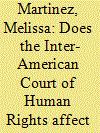

|
|
|
|
|
| Summary/Abstract |
Honduras, Guatemala and El Salvador have struggled to adopt measures of accountability and support for human rights norms since the end of the civil conflicts in the region. Many victims and activists have taken their cases to the Inter-American Court of Human Rights to gain reparations and accountability. How effective is the Inter-American Court of Human Rights at advancing human rights norms related to the cases it examines? I examine this question by developing the ‘domestic norm cycle’ theory, which extends Keck and Sikkink’s (1998) norm cycle theory. This theory captures how the ‘internalization’ of a norm takes place by examining political institutions. I argue that we can observe various stages of the ‘domestic norms cycle’ to examine how close or far the state is to fully adopting the norm. Although this article examines the levels of compliance with the Inter-American Court of Human Rights on El Salvador, Honduras and Guatemala, this theory can be applied to examine how external factors influence the development of human rights norms. This study has significant implications for how we observe support for human rights practices.
|
|
|
|
|
|
|
|
|
|
|
|
|
|
|
|
| 17 |
ID:
109558


|
|
|
|
|
| Publication |
2012.
|
| Summary/Abstract |
THE DRUG violence in Mexico no longer is a concern just to that country. More than forty-three thousand people have died in the fighting there since President Felipe Calderón initiated his military offensive against the powerful drug cartels in December 2006. Uneasy officials in the United States understandably worry not only about the potential of the growing turmoil to destabilize Mexico; they also worry about the prospect of the violence seeping northward into the United States.
|
|
|
|
|
|
|
|
|
|
|
|
|
|
|
|
| 18 |
ID:
102544
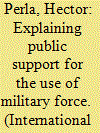

|
|
|
|
|
| Publication |
2011.
|
| Summary/Abstract |
This article examines the determinants of public support for the use of military force. It puts forward a Framing Theory of Policy Objectives (FTPO), which contends that public support for military engagements depends on the public's perception of the policy's objective. However, it is difficult for the public to judge a policy's objective because they cannot directly observe a policy's true intention and influential political actors offer competing frames to define it. This framing contestation, carried out through the media, sets the public's decision-making reference point and determines whether the policy is perceived as seeking to avoid losses or to achieve gains. The FTPO predicts that support will increase when the public perceives policies as seeking to prevent losses and decrease when the public judges policies to be seeking gains. I operationalize and test the theory using content analysis of national news coverage and opinion polls of U.S. intervention in Central America during the 1980s. These framing effects are found to hold regardless of positive or negative valence of media coverage.
|
|
|
|
|
|
|
|
|
|
|
|
|
|
|
|
| 19 |
ID:
180345
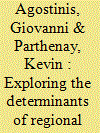

|
|
|
|
|
| Summary/Abstract |
What explains the variation in how states collectively deal with public health challenges across different regions? We tackle this puzzle by comparing the regional health governance efforts pursued within the Central American Integration System (SICA) and the Union of South American Nations (UNASUR). We show that Central America's health governance has been driven by external actors, whereas South America's was driven by states within the region, and remained insulated from external actors’ influence. We argue that the explanation for such variation lies in the interplay of state capacity and regional leadership. In Central America, weak state capacity combined with the absence of a regional leader willing to provide governance resources. This opened up space for external actors to contribute actively to regional health governance, complementing the governance of Central American governments. In South America, Brazil's regional leadership mobilised neighbouring states’ capacities by promoting a South-South cooperation agenda based on intra-regional exchanges among national health bureaucracies, which, however, proved vulnerable to intergovernmental conflicts. Through the comparison of Central and South America, the article bridges the gap between global health governance scholarship and comparative regionalism, providing new insights on the determinants and effects of regional health governance modes in the Global South.
|
|
|
|
|
|
|
|
|
|
|
|
|
|
|
|
| 20 |
ID:
138456
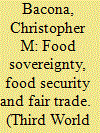

|
|
|
|
|
| Summary/Abstract |
The relationships among trade, food sovereignty and food security are underexplored. I conducted qualitative research with an influential cooperative to identify lessons that food sovereignty (FS) scholars could learn from fair trade and food security, and explore linkages among these projects. First, most co-op leaders and farmers view these projects as complementary, not contradictory. Second, state-led agrarian reforms and co-ops increase access to land, markets, water, forests and pasture, which have reduced – but not eliminated – seasonal hunger. Third, these diversified fair trade coffee-exporting smallholders could be part of a FS agenda. However, the split in fair trade suggests that only specific versions of fair trade are compatible with FS. Fourth, capable cooperatives can enhance fair trade and FS goals, and food security outcomes. Fifth, organised smallholders resisting the fair trade split could learn from the FS social movement’s strategies. Food insecurity remains a persistent challenge to both approaches.
|
|
|
|
|
|
|
|
|
|
|
|
|
|
|
|
|
|
|
|
|